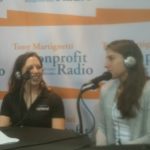
My Guests:
Ann Marie Ronsman & Alli Stephens: Text More
Volunteer training. Board work. Continuing ed. You can do all these and more by texting, with its high open and engagement rates. Our 20NTC panel explains how. They’re Ann Marie Ronsman and Alli Stephens, both with CASA Child Advocates of Montgomery County, TX.


Julie Chiu & Ilene Weismehl: File Cleanup
Are your digital files a mess? Can’t find what you know is there and co-workers putting files where you think they don’t belong? Julie Chiu and Ilene Weismehl share their tips on organizing, creating and maintaining clean shared folder drives. Julie is from Cara Chicago and Ilene is at Community Catalyst. This is also part of our 20NTC coverage.


Listen to the podcast
Podcast: Play in new window | Download
Subscribe to get the podcast
Apple Podcasts | Spotify | Google Podcasts | Stitcher
Get Nonprofit Radio insider alerts!
I love our sponsors!
 WegnerCPAs. Guiding you. Beyond the numbers.
WegnerCPAs. Guiding you. Beyond the numbers.
![]() Turn Two Communications: PR and content for nonprofits. Your story is our mission.
Turn Two Communications: PR and content for nonprofits. Your story is our mission.
We’re the #1 Podcast for Nonprofits, With 13,000+ Weekly Listeners
Board relations. Fundraising. Volunteer management. Prospect research. Legal compliance. Accounting. Finance. Investments. Donor relations. Public relations. Marketing. Technology. Social media.
Every nonprofit struggles with these issues. Big nonprofits hire experts. The other 95% listen to Tony Martignetti Nonprofit Radio. Trusted experts and leading thinkers join me each week to tackle the tough issues. If you have big dreams but a small budget, you have a home at Tony Martignetti Nonprofit Radio.
View Full TranscriptProcessed on: 2020-08-21T17:10:57.647Z
S3 bucket containing transcription results: transcript.results
Link to bucket: s3.console.aws.amazon.com/s3/buckets/transcript.results
Path to JSON: 2020…08…503_tony_martignetti_nonprofit_radio_20200824.mp3.338064872.json
Path to text: transcripts/2020/08/503_tony_martignetti_nonprofit_radio_20200824.txt
way big profit ideas for the other 95%. I’m your aptly named host. Oh, I’m glad you’re with me. I’d come down with hyperhidrosis if you made me sweat about whether you’d miss today’s show. Text. Mawr Volunteer Training Board work. Continuing ed You can do all these and more by texting, which has high open and engagement rates, are 20. NTC Panel Explains how they’re Annemarie Ron Zeman and Olly Stevens, both with Casa Child advocates of Montgomery County, Texas, and file cleanup or your digital files a mess. Can’t find what you know is there and your co workers are putting files where you think they don’t belong. Julie Chu and Eileen y Smell share their tips on organizing, creating and maintaining clean shared folder drives. Julie is from Cara Chicago, and Eileen is that community catalyst. This is also part of our 20 NTC coverage on Tony’s Take two. A free how to guide were sponsored by wegner-C.P.As guiding you beyond the numbers wegner-C.P.As dot com and buy turned to communications, PR and content for non profits. Your story is their mission. Turn hyphen two dot CEO and in a couple of weeks will have a new sponsor here is text more welcome to tony-martignetti non profit radio coverage of 20 NTC 2020 non profit Technology Conference conference, of course, had to be canceled. We are continuing, persevering virtually. We are sponsored a 20 NTC by Cougar Mountain Software Denali Fund. Is there complete accounting solution made for non profits? Tony-dot-M.A.-slash-Pursuant. Martin for a free 60 day trial. My guests on this day to coverage are Annemarie Ron Zeman and Allie Stephens. They’re both with Casa Child Advocates of Montgomery County outside Houston, Texas Casa, of course, court appointed special advocates. And Marie is director of training. And Allie is marketing and communications director. Ali and Marie. Welcome. [00:02:39.94] spk_1:
Thank you. Glad to be [00:02:40.82] spk_2:
here, gear. [00:02:42.10] spk_0:
I’m glad we’re able to work this out virtually. So [00:02:44.60] spk_4:
you’ve been [00:03:08.67] spk_0:
doing a lot on with Well, you’re you’re NTC Topic is using text SMS to train, educate volunteers and build community. So you have been doing a lot with text messaging for volunteers. Your board? How did this all? Ah, how did it get started? Was it started? Experiment And it blew up or what? To the point now where people are asking for the messages if they don’t get them. How did it get started? [00:03:14.44] spk_1:
Well, when I came on board a little more than two years ago, we had some training challenges that lots of nonprofits have, which are, you know, limited space, limited staff time. And our organization has a little bit of an upside down volunteer models. So we have a small number of paid staff and a large number of volunteers. And of course, some of those volunteers air retired. But many are working. And so it’s hard, tough, a time that works for everybody. And then, of course, space. And so we came across this technology that was being used for training in Fortune 500 companies, and, well, why don’t we try and adapt it for our environment? And, uh, really, we’re not sure how it would be received. [00:04:12.98] spk_0:
Okay, I love that You, uh, picked up something from from Fortune 500 from industry and and and tried it out. And so, like I said, So now people request the messages when they when they’re not coming, If there’s a lapse, they start wondering what happened to you. [00:05:00.44] spk_1:
Yes. So we when we started, we were very worried that our training by text was going to be seen as an annoyance and that, um, you know, it was going Teoh be seen negative by our volunteers. And actually, the opposite has has happened. People enjoy the text, they look forward to them. And, uh, you know, sometimes around the holidays or other times, we have a period of time where we don’t do texts for training or sometimes we upload our list periodically. And there’s a glitch in our database and where people off the list and they send me an email and say, I’m not getting texts, where’s our training? And that’s about the opposite of what we expected. [00:05:03.93] spk_0:
Yeah, that’s fabulous commitment that I love it. Um, now the the special advocates Are they attorneys or or not? You are some of your volunteers attorneys or no, [00:05:17.69] spk_1:
um, maybe one or two. Um, you know, from fields outside of child welfare, but in intact [00:05:22.58] spk_0:
money. Okay, [00:05:32.80] spk_1:
In Texas, they’re all volunteers from various walks of life, which is part of what makes this training so valuable. So we have stay at home moms, and we have a retired superintendents, and we have, um, you know, it’s presidents from oil and gas companies. And we have teachers and and the whole engine that makes training a challenge, because everybody is coming with a different skill set. [00:05:48.24] spk_0:
Um, and some of what you’re doing, Ali is is, um, continuing education training. Right? [00:06:50.20] spk_2:
Right. So are advocates are our volunteers were actually required to have Emery? Is it 16 hours, 12 12 hours of continuing education annually after they have completed their first year as an advocate? We have pre service training. That’s 30 hours, plus three hours of court observation. But then, after that, first year service advocates have to maintain 12 hours of retuning education. So that was what Emery was talking about earlier. You know, it’s hard because it is managed wearing required, but in meeting on their names are volunteers needs, um, you know, it was a definite challenge, So just the way we thought it would benefit them and making it convenience. Um, And where they could basically watch or train at their time, their own time? Yeah, it’s worked well. [00:06:51.47] spk_0:
And how about the board communications? What do you using texting for their [00:07:23.57] spk_2:
So that sort of something we’ve we’ve just dipped our toes in, but I’m way sort of launched the Advocate training first on dhe. We thought that was a good Well, that was really our goal at first was to train advocates. But then once we sort of got into that, we realized there were lots of opportunities that we could train. Also are board members, possibly staff and yeah, in ways that [00:07:25.24] spk_0:
we [00:07:39.14] spk_2:
had not done before. You know, in person training was our primary source of training. So this was something that was experimental. And we’re expanding to board training now, okay. [00:08:01.62] spk_1:
And our board members to come from a wide variety of backgrounds, and so they’re used to being the smartest and the best educated people in the room. And eso This gives them a way to learn about the field of child welfare. You know, while they’re waiting to board a plane or sitting and waiting for a meeting in the end and, you know, helps up to understand the work we do so that they can better help serve our organization. [00:08:08.74] spk_0:
And this transcends generations. Do you say from Gen. Z to baby boomers, right? [00:08:21.75] spk_1:
Yes. Everybody has really enjoyed it. And again, the baby boomers were the ones that we thought would not embrace this and really have they really have? [00:08:25.64] spk_0:
Are they some of the ones who look for the messages when when they don’t come? [00:08:29.64] spk_1:
Yes, yes, [00:08:53.55] spk_0:
I’m thinking probably more so. Retirees and wondering what it’s time. It’s time for my training. Where’s my yes? OK, where the Gen Z’s brother like it’ll come and you know I know, I know. I’m still in the queue where it’ll come. Okay, Um so let’s dive into some of some of the details, um, on then. Oh, you’re also doing just in time training. So last minute, I guess, like court, court decisions or things like that. I’m sorry. Before we get into the some of the details, what’s your just in time training? What is that? [00:09:31.14] spk_1:
Well, if we haven’t that, you know, something changes in the way either. Are you know, Department of Family and Protective Service is is working. They pass a new policy or the change in the way courts are working. OK now with the Corona virus. But we’ve been using our drip learning or learning by text, um, extensively to help give our advocates the tools they need to help our kids in this it remote impairment that we’re in. [00:10:05.04] spk_0:
Oh, and I neglected to say at the outset there, I’m I know you are both well and safe, and I meant to say that earlier. I’m glad. You know, I’m glad this worked out, but you’re also both safe and healthy. No. Good. Um, so, yes. So that sort of breaking news, you know, like a new policy at the state level or at a county level or something like that. Okay. Um, all right, so let’s go in. I mean, so how does it How does it work? Logistically, Help. Help Listeners. Understand, I guess. What? What you need to set up like there’s a technology platform you need where you advance your advanced load messages or something like that. How does that work? [00:11:49.08] spk_1:
Yes. So we work with a company called Engaged by Cell, and they are the hosting platform. And, um then we, um, with a left, some of our own materials. So Allie and I work together and make some videos and some different documents that might be meaningful for our organization. Uh, I also pulled a lot of materials off of YouTube off of, um, resource is from other sites. Articles urge. Um, the goal is that all the videos are articles can be completed in 3 to 5 minutes. And you know, really what research that was. Our attention span has continued to x shorter and shorter. So, um, we really have held fast to that type rain. And, um So when are advocates click detect, and that has a little sentence or to do about what the topic is. And when the link, they know that within 3 to 5 minutes, the activity will be a complete, and we use a whole host of different topics. Uh, what’s nice about it is you can set it up, you know, seasonally if you want to. So, uh, example, in our field of work, the holidays are very hard for kids that have experienced trauma. Um, and so giving our advocate some tips about how to help kids, how to help caregivers put things in place. Um, so that, um you can anticipate and meet the needs of the kids in their homes way. Also use it around back to school time. Uh, and so, um and then we use it for our organization. So for putting on a policy, it may go out an email, but it also goes out in text with learning, which we call drip learning. Andare learning by text has about 85% open. Right? Um, and as you know, email is much below that. And, uh, so we’ve had a lot of success with it. [00:12:22.32] spk_0:
Okay, Ali, your marketing communications. So you’re writing, I guess a lot of the content that is already all you know, all the content that’s developed in house, as opposed to the content that Emery was saying She goes out and curates [00:13:53.64] spk_2:
since a team effort. I mean, Anne Marie and I started sort of came up with what we call buckets. So things that we thought topics we thought would be useful, whether it was educational, ab, etc, medical advocacy, legal advocacy. Um, and then we rely on a lot of our staff who special. I have a variety of backgrounds, may specialize in sex trafficking or, um, family, you know, toddler aged Children or teens. And they can kind of help us, um, collect that content. Henry does a lot of research and digging up what and if it doesn’t exist. That’s when we create it. So that’s something that’s already out there. You know, we don’t were very small. I mean, Anne Marie and I are essentially a team of two and on staff total it costs. We have about 2020 paid staff members. Um, for volunteers. We have over 300. So there’s very few of us that, um can pull together the content for this so we don’t try to reinvent the wheel. If something already exists out there that that we like and is useful to our volunteers in terms of training, we utilize that. But if it’s something that is especially thing that’s unique to our county or are advocates, that’s when we do our own videos or own documents or our own and log posts or whatever. [00:14:39.87] spk_0:
It’s time for a break wegner-C.P.As paycheck protection program. Loan forgiveness. It’s still out there staring you down. You need to get your forgiveness application in. Wegner has a free webinar that explains P P p loan forgiveness. Go to wegner-C.P.As dot com. Quick resource is and recorded events now back to text more with Anne Marie, Ron Zeman and Olly Stevens. It sounds like you have a whole, um, production schedules. Not right. But a whole schedule of when, When? Throughout the year. Different messages. They’re going to be going out. [00:15:22.81] spk_2:
We dio um, when we first started, we thought we would focus on a topic like a specific topic each month. Where And we still sort of do that. You know, if it’s back to school, we’re certainly gonna be focused on back to school and, um, effects of of the destruction of our the disruption of schedule or lack of schedule for kids who have experienced trauma. But and really, we we do a lot of like Henry said just in time training articles that come out. Um, we just give them a variety of of materials and information to consider. Learn about. [00:15:26.44] spk_0:
Do you have any tips for writing the, um, the text message that the person actually sees before they click through to the other content [00:15:42.24] spk_2:
is turkey. I think we have in reads like 100 40 characters. Yes, you. We better [00:15:42.74] spk_0:
get [00:15:47.44] spk_2:
good at being succinct and, um, trying to make it enticing, But you don’t have a lot of characters. [00:15:58.60] spk_0:
Okay. Um, So, uh, what else Um, yeah, I know you have high open engagement rates. What What else? What other ideas do you have? People like we thinking, You know, this could work for their volunteer training. What other advice? [00:16:08.81] spk_4:
But when one of [00:16:44.02] spk_1:
the things that’s really nice about it is that people can click the link when they have time to view it. So we have some people who click a distance. They get it. We have some people that are sitting at their kid’s soccer camp Saturday and maybe do a month’s worth of of texts at once. And then we pull a report on the back end. Um, and the way we’ve chosen a handle, it is, um, you give our kids five minutes of continuing education credit for each, you know, training that they do each strip learning. And then that does that doesn’t telling a lot of [00:16:46.23] spk_0:
12 hours, right, [00:17:50.38] spk_1:
right, But over. You know, it’s 40 minutes a month, and so over the course of a year, it does add up and, um, no, it just ah, and then also they can use that information that can pass along to placements where the kids are plate, you know, if they have a resource that ah, you know, video that they found helpful that they think might be helpful to a foster parent. They can pass that along to them. And although our organization is small and we haven’t used it a lot for training for employees in a look non profit that that has a larger group of staff members work equally Well, it’s a really im not particularly Tuckey. It’s pretty intuitive to use pretty, pretty logical. And, um, you know, Allie, I find the content and alley makes it pretty. And, um, you know, it really just has worked out well for us, and it’s ah, very cost effective. But also, I can I can sit down, uh, you know, for a day or a day and a half and do all of our continent for a month or six weeks. Ah, yeah. Okay. And part of that is also finding the content. [00:18:09.44] spk_0:
Right. Okay. Um, Ali, can you talk to some of the costs? I know, uh, you both said it’s cost effective. How did you pay by the message? Oh, are is that a standard rate for the year with a cap on number of messages or on the minute, How does that work? [00:19:13.29] spk_2:
So we do have an annual there is an annual fee, and we are, ah, out of allotted a certain amount of text messages We actually use the majority of our text go out and are used for trained by cell, engaged by cells, the platform. And then they have to kind of stub platforms during my cell and also give by cell. So please do use it also on four developments. It’s a very small, you know, that’s we started it as trained my cell. We started the train myself technology, and then we’ve done it for a couple of giving Tuesday and our own fundraising campaign. So we’re just that last year’s our first year doing that as well. So do use it for that as well. But I think we just did the math on this or executive director did, and I think it’s about messages that right, Emory? [00:19:39.83] spk_1:
I didn’t see what her mass ended up coming back, but basically what you do is you you, by a certain amount of, um, text messages and um trained myself been really good, giving us a non profit rate and which is I believed to be much full. Oh, you know what they charge in? And, um Oh, and then we use we buy one bucket and some of those air used for fundraising. A smaller amount in our organization and the rest are [00:19:54.64] spk_0:
used for training. Yeah. Okay. Um, I know you both said it’s cost effective. Um, what [00:19:55.27] spk_1:
we’re sending out, we’re sending out to tax a week. [00:20:06.45] spk_0:
Oh, yeah, that’s right. I was gonna thank you. You reminded me where wanted to go. You said 40 minutes, 40 minutes a month. So and it’s five minutes. Right? So that sounds like eight messages per month, twice a week. Okay, [00:20:21.62] spk_1:
way wanted it to be, um, you know, enough to keep people engaged, but not so much that it became an annoyance. And we generally in the text out between 10 AM and two PM um, and usually Tuesday, Wednesday or Thursday, I’m [00:20:30.26] spk_0:
tested different times of day in different days. And then [00:20:33.57] spk_1:
that that was actually the information that trained by cell gave us as faras the best times for people to open texts and [00:20:51.34] spk_0:
10 to 2 and Tuesday, Wednesday, Thursday. Correct? Yep. Okay. Okay, Um I mean, we don’t have to wrap it up, e, I’ll leave it. I’ll throw it up to either of you, but we can if you feel like we’ve covered it. Anything either. If you wanna, you wanna add? [00:21:37.72] spk_1:
I think one of the other things that has been interesting about this technology is how it has really built a virtual community. Um, and, uh, that wasn’t our intense. It actually wasn’t even non. But, you know, really, when you have advocates are advocates are all working individually. They work with individual kids or an individual family of kids to the placements. And so a lot of the work that we do is kind of an isolation that are volunteers do. And so, um, you know, they’re all getting this same article. And so what Southern? The office they can say, Hey, you know, did you see? Did you see that article about whatever? And so it’s been a really good at community building tool and, um, has has, which wasn’t on a non expected benefit. [00:22:07.24] spk_0:
Okay, we’re gonna leave it there, then sound right. All right. All right. From court appointed special Advocates, child advocates of Montgomery County outside Houston, Texas. Anne Marie. Ron Zeman, director of training. And Olly Stevens, marketing and communications director. Thanks so much for sharing and please stay safe. [00:22:15.74] spk_1:
Thank you very much. [00:24:14.40] spk_0:
All right. And thank you for being with tony-martignetti non profit radio coverage of 20 NTC virtually sponsored by Cougar Mountain Software. The Nolly Fund Is there complete accounting solution made for non profits tony-dot-M.A.-slash-Pursuant er mountain for a free 60 day trial. Thanks so much for being with us. It’s time for Tony’s Take two unleashed the game changing power of planned giving at your non profit. That’s my free. How to guide to help you get started in planned giving. Get your program started. It will help you decide if you’re ready for planned giving. If you’re not ready, of course you can stop right there. You want to read any further? If you are like most are, it’ll show you how to promote your new program and to give you strategies for stewardship of your new plan to give donors. How do you get the guide you text you text guide to 56525 were texting more today. Remember text more text guide to 565 to 5. That is Tony’s Take two. Now it’s time for file cleanup. Welcome to tony-martignetti non profit radio coverage of 20 NTC. That’s the 2020 non profit technology conference. Were sponsored a 20 NTC by Cougar Mountain Software. My guest today kicking off day three of what would have been the conference are Julie Chu and Eileen Y Smell. Julie is a quality. The quality and standards manager at Kara Chicago and Eileen is knowledge and database knowledge and data manager at Community Catalyst. Good morning, Eileen. Julie. Welcome. Morning. Morning. Your workshop topic is from chaos to clarity. Practical strategies for file cleanup. Eileen, let’s start with you. Why is this? Uh, it sounds daunting. It sounds dull. Why should we motivate us? Why should we be paying attention to our Ah, our shared files? [00:25:32.04] spk_4:
Yes. Um, anything but dull for us. We We were doing it in preparation from a move from the our local server to a cloud based file system. And we were moving partially because we needed the better technology. But also, people could not find things. There were multiple drafts, people even using the very limited search function of, um, with our local server system, people would search for things, find multiple copies, not know which is the right one. There people were storing things in email attachments. There was no central way to have our information accessible to everybody on DSO. It was critical, uh, for us to do our work and move forward to both clean of our files, which was actually a first step to get a folders. I mean, you could clean up our folder structure and then to go through our files and really get rid of things that we didn’t need organized. The things we did need to make sure that people could, uh, could get their hands on what they need in a timely way and get about the business of doing their work. [00:25:49.65] spk_0:
Yeah. You want to build? I’m not gonna pick that up now. Sorry. Um, this is what happens, You know, working from home with multiple lines, it will stop eventually. Yeah, people, people need to be able to go to their go to their directory and get what they need quickly not wondering whether we’ve got the right file or the right draft, etcetera under. Of course, Julie, How did this come up for Cara Chicago? [00:27:21.17] spk_3:
Yeah, So are our stories a little bit different from my leans, But we did have originally were using a bowel server and it became crowded with dressed over 20 years worth of files. Eso we had a top folder structure that had over 100 folders on dhe. All of them were accessible by anybody in the organization. Even though things like performance reviews and personal files were stored in those folders. Eso they kind of had, like, they carried the legacy of how the organization had transformed over the years over the decades. Really? So you would see, like, old apartment named files in the in, In In the top level folders. Um and so we decided a couple of years ago that we needed Teoh do exactly what I lean with, saying we needed to make sure that staff were able Teoh access the files being eat it quickly. And things like organizational or enterprise resource is like the organizational map or are master calendar. I’m weren’t buried in nested folders, so we did that and we and basically looked at what each team was using currently, and moved those folders, those files only over to a new foul server. So we’re in a different file server, which we didn’t move to the cloud like Eileen’s organization did. Um, we plan to do that in the future, but at this point, we’re all using we’re using another clean folder structure in a different belt server. [00:28:31.47] spk_0:
I want you both to know that I am sympathetic to this. Um, I’m very scrupulous about creating top level folders that for it to be a brand new category or ah, it’s a high threshold for me. But when I’m both when I’m at a client, you know, using a directory that I have access to or when I’m just organizing my own folders, I can’t my own folders, you know, including my consulting. I can’t think the last time I created a top level thought folder, so I’m scrupulous about that. I’m I’m sure it doesn’t carry down to the level that the two of you were involved in, but a taste of the top level. You know, I don’t think every new activity requires a new folder, you know, for the month or the day or something, like, you know, so I’m at least at least cautious about that. The top level. Um, you [00:28:35.71] spk_3:
like to hear that? All [00:29:02.94] spk_0:
right. Thanks. So trainable. Credible. But I know it goes much deeper than that way. We will to um so I guess I don’t know. It is a fair place to start. Like, how do you get your arms around this project? That who should be involved in all the all the users or just a representative from each team or something? How do you How do you get the project? Ah, the the reorganization kicked off. Julie, let’s start with you. [00:29:14.57] spk_3:
Yeah, Yes, that’s a great question in that. That is, that was actually going to be the main focus of our present er session. So at north [00:29:16.49] spk_4:
of our [00:31:02.69] spk_3:
organizations, we ended up meeting with departments with individual departments. Before we met with those teams, though we had to ask each teen I mean work with each team Teoh and asked him to do some prep work. So we wean. Maybe could give a little bit more information on that because I really admire the way that she kind of galvanized each team to do that work for my organization. We I basically gave them a template, a spreadsheet, and asked them to inventory the things that they actually use on a regular basis. And I feel like that was really tedious work for the organization or the departments. But I think it really got them to think about Thean importance and the value of each of the things that they use and save on the file server. So that really just gave people kinds a kind of perspective of what they needed to bring with them into the new file server. Eso before, after after they did that, we would I would meet on Guy would organize this meetings with each team Teoh line by line and go through that spreadsheet and to talk about whether or not there were duplicates of the of each item in. Sometimes there were, um, and sometimes people did not know that they were working off of. I’m the same file but saved in different locations. So things like that kind of surfaced. So meeting with each team was definitely essential even after they did that initial inventory, because I found that teams weren’t talking about those things. They they needed somebody from the data and tech team to kind of organize them and kind of organize that conversation. I feel like, um, you know, my work and as well as Eileen’s working this project was really the importance of it was really to Teoh organize those conversations because they were not happening, [00:31:11.73] spk_0:
All right. I mean, before we go to you on the same question, you know how to get started. I just wanna ask Julie. Did those that spreadsheet did that go down to the file level? So it was hierarchically organized spreadsheet? [00:31:45.96] spk_3:
Yeah. Sometimes they actually did go down to the file level most of the time. Most departments have just so many individual files that we ended up just talking about folders, which it’s fine to, um, which was fined Teoh. We would just have to revisit individual files once we moved things over to the new file server. Just make sure that we were truly keeping on Lee the things that we really needed and not some spreadsheet that was really important, you know, a year or two ago, but not no longer important. [00:32:11.83] spk_0:
People keeping old, um, male query queries of non queries, trying to say um Mail merges Mount Mel. Murder number emerges Labels. Yeah, exactly. Envelope files. Okay. All right, Eileen, about how about you? Where How did you kick this off? Help listeners understand how to get started with a project like this. [00:32:40.57] spk_4:
And I do have to say that part of we model I modeled our way of doing it on Julie’s. Um, I had put a query out to the end 10 list. Serve is far. Aspinall cleanup. Julie responded. And so we actually this idea of working by program we I took from Julie, We completely [00:32:45.37] spk_0:
OK, Julie. Is that why you say you admire Eileen’s work because she copied yours? [00:32:57.34] spk_3:
I think Eileen took what we did. And just like this was 10 times better. So that’s true. Admiration. [00:32:59.64] spk_4:
Mutually ists. [00:33:31.54] spk_0:
Time for our last break turn to communications relationships. The world runs on them. We know this turn to is led by former journalists. So you get help building relationships with journalists. Those relationships will help you when you need to be heard so that people know you’re a thought leader in your field. Turned to specializes in working with nonprofits, their turn hyphen two dot ceo, we’ve got, but loads more time for file cleanup. [00:35:29.24] spk_4:
Really hard to imagine sending people off to their corners and telling them just to clean. I could not imagine that happening on and it’s been tried before. And so this whole idea of doing it in groups, which there were some, you know, some higher ups that were naysayers that said, You know when and you just have people clean But the manager’s overall, we’re so grateful that I was scheduling these three hour slots, which seemed impossible, like I thought there’s no way they would do it. They were very excited, believe it or not, uh, excited about having these three hours lots to sit with their team because they said they would never do it and it has to be done. And so it really it was both, um, great for getting the work done, but also forgetting staff excited about the project and able to, ah, to see the value of it and to be a part of the solution later on. And so the prep work, which Julian mentioned that I did, we didn’t I didn’t do the inventory, um, but I had a knee email went out to managers encouraging people to do some prep work before the three hour meetings. And so I created what I called the vault, Um, which I described to people as a storage unit in another state that you need special permission to get into. So what it was is a place that for people who didn’t want to delete things, it’s like you don’t have to delete it. Just put it in the vault, you know? So it’s like it’s something that they really don’t need, but they can’t let go of So we put it in the vault, keep it out of the way. Um, now that’s different. For somewhere, they said, we need a historic archive because we sometimes need to refer. It is like Keep that. Don’t put that in the vault because you need that. So that’s there’s difference between an active archive of the history of the program and the balls, which is essentially one step removed from from deletion. And so I asked people to, you know, creative all folder and start moving things in. I gave them just, you know, simple, simple things, just so it would be overwhelmed. Look for drafts you know, to get rid of drafts. Um, I actually should have refreshed my memory of what the other one’s work, but also, you know, looking for boulders where there might be just one file, um, to get rid of. And so I just gave them a little bit of prep work and then that most of them did and then, wonderfully, one of our senior managers, um, who was part of that, wrote a follow up to say that their session was incredibly successful because of the proper work. And so that encouraged others to do the proper to. [00:36:11.41] spk_0:
And then what did you do in these three hour meetings with them? [00:36:42.08] spk_4:
So we did it. They were all a little different. Interesting. We had a template, and we actually unlike Julie did these herself and we hired. I had a consultant to facilitate these, and depending on the program, they went different. So basically we would go through in the best case scenarios go through just systematically folder by folder by folder. But But in the prep work, sometimes they would write, deletes with discussion. And so we go through the those two. It’s like some that people had already identified, we might be able to delete, and we really literally deleted them in real time or moved them to a vault in real time. [00:37:13.93] spk_0:
Okay, how about the the organization? So we’ve talked so far about what files may be needed or not needed, needed actively or needed a ZX ah, vault file. But about the folder structure, the hierarchical structure. Is there people competing around that? Is that difficult to reorganize? People used to going to a certain nested folder and finding what they need. And now it’s gonna be a different name and a different different hierarchy. Is that Is that trouble? [00:38:28.12] spk_4:
Well, we had It hasn’t been. We had a folder structure working group. It was about across organizational group, about five people who we felt identified them based on that they could see the forest and the trees. That’s what we needed. Systems people who also, you know, strategy people, but knew what was important from a systems level and working with the same consultant. And we started looking at the existing one. She had done a lot of discovery to find out. Um what? The organ it not my phone is ringing what the organizational, um needs are, um And then we started just moving pieces around until we got a structure that reflected the way we do our work. And so by the time this working group was done because their chorus organizational and because they were taking this to their teams when we were when we released the structure, people were very relieved. For the most part, there’s always resistors. You know, Julie, right? Well, or people who were You know, if that resistors people who were slower to accept it on. And so, yeah, [00:38:51.93] spk_0:
Kallstrom’s I like to call them recalcitrance, but they you have to try to bring them along. Julie, let me ask you about something that I lean alluded to. And that wasn’t a problem for her. About, um, leadership buy in for the time that this is gonna take was that we haven’t had that go for you. Or do you have advice about it that’s basically making the case for why so valuable that your leadership supports it? [00:39:49.48] spk_3:
Yeah. I’m really glad that you asked that because we ended up. I am a manager and I ended up. I’m talking about how to get leadership on board. We prepared like a 20 minute presentation on the leadership team meeting. It only took 20 minutes to actually Dio, um we kind of expected, like Eileen with saying some resistance at that level just because this is a file cleanup project and we were proposing that this would take, like, a year. Um, and we went into the leadership team meeting thinking, you know, just prepared for the worst. You know, eso we went through with it and they were actually very, very enthusiastic about it. We were expecting, at the worst, just resistance to the timeline, at least. Or, um, you know, just a plain, like ambivalence about it. But people were actually very enthusiastic because it impacts daily routines. We actually also did a pre survey leading up to that leadership team meeting just to amassed staff. How long they’re actually spending searching for files what they would want in a new folder structure things like that. And we took those results to that leadership team meeting put in the presentation and we, you know, like from that survey, we found that people were spending upwards of and three hours each week searching for items on trial [00:40:26.16] spk_0:
that that’ll help make the case [00:40:27.82] spk_3:
Exactly. Yeah, [00:40:29.04] spk_0:
hours they aggregate the time over a week. Three hours. Okay, Right for [00:40:51.54] spk_3:
over items. And so we way used to say that. Yeah, that would be That would mean that overall of about one full time workers. Time was actually spent each each month and little for files. So that was a really, you know, like, hard hitting kind of figure that we used for leadership team, meaning toe and really illustrate how much time was being lost doing this day to day work. So that really, really proved the case, and we started at that leadership team level, presented the plan. Teoh, do the team. My team meeting also asked that, and they support the prep work that each team would have to dio on day were They were very, very enthusiastic about that after hearing that. [00:41:46.70] spk_0:
Okay, so you both had management enthusiasm. Enthusiasm? Yeah. Yeah. Okay. Um, s So we still have some time together? If there’s mawr that, uh, we haven’t covered that you want you think is important for listeners who might take this on either of you is where should we go from here or yeah, anything. I have recovered it, and we exhausted the topic. [00:42:12.70] spk_4:
Um, I think the only thing is just that, uh, for people who think that it sounds, I mean, back to the beginning of it, sounding dry that if it’s phrased is is what Julie was talking. I was just so critical to the work that it’s not administrative task. It’s really a programmatic strategic, um, piece of work. That means that people can focus on what they’re doing versus looking for things, which is no small, no small thing when you know, non profits are strapped and need to really make the most of their time in the resource is [00:42:38.85] spk_0:
yeah. All right. We’ll leave it there, then. That’s yeah. You want to be ableto find what you need quickly, a couple of clicks and you should be there. All right. Thank you very much. That’s Ah, Eileen y smell, knowledge and database. Sorry. Did that First time to knowledge and data manager. A community catalyst. Um, your Providence, Rhode Island. Um, and Julie Chu is quality and standards manager at Cara Chicago. Eileen, Julie. Thank you very much. Thanks so much for sharing. Thank you, [00:42:54.57] spk_3:
tony, [00:44:01.10] spk_0:
they well, and thank you for being with tony-martignetti non profit radio coverage of 20 NTC sponsored by Cougar Mountain Software. Thanks so much for being with us next week. We’ll have more from 20 NTC. If you missed any part of today’s show, I beseech you, find it on tony-martignetti dot com. You that vacuuming in the background, good work going on, and they clean up very well, Uh, before they depart. I appreciate that. So we persevere. Were sponsored by wegner-C.P.As guiding you beyond the numbers. Wegner-C.P.As dot com Can you hear me? And by turned to communications, PR and content for nonprofits, your story is their mission. Turn hyphen two dot ceo. Our creative producer is clear, Meyerhoff shows Social Media is by Susan Chavez. Mark Silverman is our Web guy on this Music is by Scott Stein with me next week for non profit radio Big non profit ideas for the other 95% go out and be great

 Self-described “data nerd” Emily Patterson talks you through online tracking and analyzing of your offline activity. She’s founder of
Self-described “data nerd” Emily Patterson talks you through online tracking and analyzing of your offline activity. She’s founder of 




